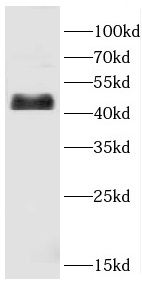Products
CD209 antibody
| Size | Price |
|---|---|
| 100µg | Inquiry |
- SPECIFICATIONS
- FIGURES
- CONDITIONS
- FAQS
- Product Name
- CD209 antibody
- Catalogue No.
- FNab01443
- Size
- 100μg
- Form
- liquid
- Purification
- Immunogen affinity purified
- Purity
- ≥95% as determined by SDS-PAGE
- Clonality
- polyclonal
- Isotype
- IgG
- Storage
- PBS with 0.02% sodium azide and 50% glycerol pH 7.3, -20℃ for 12 months(Avoid repeated freeze / thaw cycles.)
- Immunogen
- CD209 molecule
- Alternative Names
- CD209 antigen|C-type lectin domain family 4 member L|Dendritic cell-specific ICAM-3-grabbing non-integrin 1 (DC-SIGN antibody, DC-SIGN1)|CD209|CLEC4L antibody
- UniProt ID
- Q9NNX6
- Observed MW
- 45 kDa
- Tested Applications
- ELISA, WB
- Recommended dilution
- WB: 1:500-1:2000
 human placenta tissue were subjected to SDS PAGE followed by western blot with FNab01443( CD209 Antibody) at dilution of 1:1200
human placenta tissue were subjected to SDS PAGE followed by western blot with FNab01443( CD209 Antibody) at dilution of 1:1200
- Background
- Pathogen-recognition receptor expressed on the surface of immature dendritic cells(DCs) and involved in initiation of primary immune response. Thought to mediate the endocytosis of pathogens which are subsequently degraded in lysosomal compartments. The receptor returns to the cell membrane surface and the pathogen-derived antigens are presented to resting T-cells via MHC class II proteins to initiate the adaptive immune response. On DCs it is a high affinity receptor for ICAM2 and ICAM3 by binding to mannose-like carbohydrates. May act as a DC rolling receptor that mediates transendothelial migration of DC presursors from blood to tissues by binding endothelial ICAM2. Seems to regulate DC-induced T-cell proliferation by binding to ICAM3 on T-cells in the immunological synapse formed between DC and T-cells. (Microbial infection) Acts as an attachment receptor for HIV-1 and HIV-2(PubMed:11799126, PubMed:12502850, PubMed:1518869). Acts as an attachment receptor for ebolavirus(PubMed:12502850, PubMed:12504546). Acts as an attachment receptor for cytomegalovirus(PubMed:12433371, PubMed:22496863). Acts as an attachment receptor for HCV(PubMed:15371595, PubMed:16816373). Acts as an attachment receptor for dengue virus(PubMed:12682107). Acts as an attachment receptor for measles virus(PubMed:16537615). Acts as an attachment receptor for herpes simplex virus 1(PubMed:18796707). Acts as an attachment receptor for Influenzavirus A(PubMed:21191006). Acts as an attachment receptor for SARS coronavirus(PubMed:15140961). Acts as an attachment receptor for Japanese encephalitis virus(PubMed:24623090). Acts as an attachment receptor for Lassa virus(PubMed:23966408). Acts as an attachment receptor for marburg virusn(PubMed:15479853). Acts as an attachment receptor for Respiratory syncytial virus(PubMed:22090124). Acts as an attachment receptor for Rift valley fever virus and uukuniemi virus(PubMed:21767814). Acts as an attachment receptor for west-nile virus(PubMed:16415006). Probably recognizes in a calcium-dependent manner high mannose N-linked oligosaccharides in a variety of bacterial pathogen antigens, including Leishmania pifanoi LPG, Lewis-x antigen in Helicobacter pylori LPS, mannose in Klebsiella pneumonae LPS, di-mannose and tri-mannose in Mycobacterium tuberculosis ManLAM and Lewis-x antigen in Schistosoma mansoni SEA(PubMed:16379498). Recognition of M.tuberculosis by dendritic cells occurs partially via this molecule(PubMed:16092920, PubMed:21203928).
How many times can antibodies be recycled?
First, usually it's not suggested to recycle antibodies. After use, buffer system of antibodies has changed. The storage condition of recycled antibodies for different customers also varies. Thus, the performance efficiency of recycled antibodies can’t be guaranteed. Besides, FineTest ever conducted the antibody recycling assay. Assay results show recycling times of different antibodies also varies. Usually, higher antibody titer allows more repeated use. Customers can determine based on experimental requirements.
Notes: After incubation, we recycle rest antibodies to centrifuge tube and store at 4℃. High titer antibodies can be stored for a minimum of one week. Reuse about three times.
What are components of FineTest antibody buffer?
Components of FineTest antibody buffer are usually PBS with proclin300 or sodium azide, BSA, 50% glycerol. Common preservative is proclin300 or sodium azide, which is widely applied in the lab and industry.
How about the storage temperature and duration of FineTest antibodies?
Most antibodies are stored at -20℃. Directly-labeled flow cytometry antibodies should be stored at 2 - 8℃. The shelf life is one year. If after sales issues for purchased antibodies appear, return or replacement is available. Usually, antibodies can be still used after the one-year warranty. We can offer technical support services.
Is dilution required for FineTest antibodies? What’s the dilute solution?
Directly-labeled flow cytometry antibodies are ready-to-use without dilution. Other antibodies are usually concentrated. Follow the dilution ratio suggested in the manual. Dilute solution for different experiments also varies. Common antibody dilution buffers are acceptable(e.g. PBST, TBST, antibody blocking buffer).
How to retrieve antibodies for immunohistochemistry?
Common retrieval buffers: Tris-EDTA Buffer(pH 9.0); Citrate Buffer(pH 6.0)
Heat induced antibody retrieval:
Method 1: Water-bath heating: Put the beaker with retrieval buffer and slide in the boiling water bath. Keep the boiling state for 15min. Naturally cool to room temperature;
Method 2: Microwave retrieval: Put the beaker with retrieval buffer and slide in the microwave oven. Heat at high power for 5min, Switch OFF for 3min, Heat at medium power for 5min. Naturally cool to room temperature.
How to choose secondary antibodies?
(1) Secondary antibodies react with primary antibodies. Thus, secondary antibodies should be against host species of primary antibodies. E.g. If the primary antibody is derived from rabbit, the relevant secondary antibody should be against rabbit. E.g. goat anti rabbit or donkey anti rabbit.
(2) Choose secondary antibody conjugates according to the experimental type, e.g. ELISA, WB, IHC etc. Common enzyme conjugated secondary antibodies are labelled by HRP, AP etc. Fluorescin or dye labelled secondary antibodies are applied in immunofluorescence and flow cytometry(e.g. FITC, Cy3).
